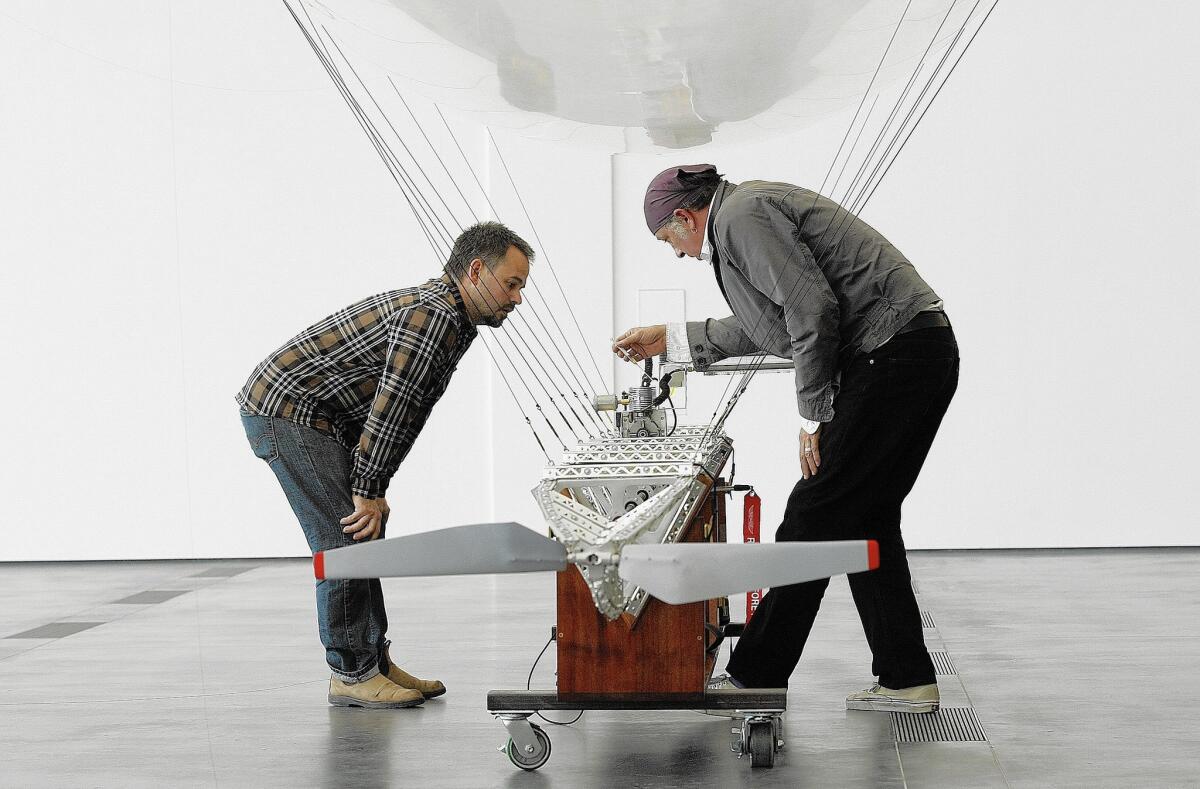Review: Chris Burden’s ‘Ode to Santos Dumont’ inspires wonder, delight

- Share via
In the 1970s, Chris Burden’s radical performance art courted danger and grappled with violence.
He had himself shot, conducted harrowing endurance tests, crawled bare-chested over glass on a dark city street, held a TV talk-show host hostage at knifepoint on camera and was kicked down two flights of concrete stairs during the opening of the 1974 Basel Art Fair.
Burden’s remarkable final sculpture, which goes on view Monday at the Los Angeles County Museum of Art, performs a sly and elegant reversal. It rescues today’s most controversial weapon of war — a drone — and spirits it away from dark and shadowy realms of death and destruction.
This unmanned drone doesn’t surveil you, you surveil it — with wonder and delight. As an artist, Burden came in like a lion and went out like a lamb.
The show at LACMA, where Burden’s temple of streetlamps “Urban Light” stands out front, is an elegiac but blissful farewell to an extraordinary artist. His unexpected death last week at 69 was greeted by an international wave of shock and sorrow. His last work, the magnificent flying machine “Ode to Santos Dumont,” will remain on view for five weeks in the Resnick Pavilion.
Burden’s grueling performance art thrummed with humanity’s endless enthusiasm for cruelty and pain, which he absorbed into his own body. His lovely last work, completed just weeks ago, at first looks as if it might have been made by a completely different artist.
A kinetic airship, its polished design was based on the dirigible that famously circled the Eiffel Tower in Paris in 1901, causing a worldwide sensation. A lyrical, even ethereal sculptural poem to disembodied flight, “Ode to Santos Dumont” can easily be seen as a melancholic but fully reconciled song from an artist who knew that mortality was approaching.
The sculpture actually evolved over nearly a decade of research, development and fabrication. Drawings and engineering notes piled up along the way.
The cigar-shaped balloon, 40 feet long and fabricated from translucent vinyl, creates a floating lozenge of softly diffused light. The perceptual play of its luminous volume moving through space recalls the radiant environmental scrims of Light and Space artist Robert Irwin. Forty-five years ago, Irwin was Burden’s influential teacher in the master of fine arts program at UC Irvine.
Beneath the helium-filled balloon, a 22-foot-long gondola made from a child’s Erector set hangs suspended. Housed within is a small, strangely elegant gasoline motor.
Based on an engine employed by Alberto Santos-Dumont a century ago, it was beautifully hand-built for Burden by machinist John Biggs. The motor alone took seven years to perfect.
The motor drives a shaft attached to a propeller at the back, while the dirigible is anchored to invisible tethers affixed to pivots in the floor and ceiling. When assistants start the engine and release the balloon from its cradle, the buoyant form drifts to a height just overhead.
Not remote-controlled, it automatically glides around a graceful, 60-foot circle, repeating the loop during a 15-minute journey. The flight is self-contained and self-sufficient.
The voyage starts out eliciting a wide-eyed grin. The motor emits a gentle fluttering sound, like a playing card folded and stuck with a clothespin onto a kid’s bicycle-wheel spokes.
A languorous breeze stirs when the balloon goes past. As minutes tick by, an unexpected sense of contemplative calm envelops a viewer.
Burden had made flying sculptures before.
In 1980 he fashioned “C.B. Airforce,” a fleet of 40 balsa wood model planes, each equipped with a firecracker. Later, suspending a kayak from the ceiling, aimed toward a projected image of a hovering helicopter and buffeted by industrial fans, as if it were an arcade game, 1983’s “The Flying Kayak” merged the turbulent fluidity of water and air.
In 1996 “The Flying Steamroller” sent a 12-ton piece of heavy machinery aloft, attached to a pivoting arm with a massive counterbalance weight at the other end. The artist piloted a huge steamroller at high speed until — miraculously, if inevitably — the behemoth lifted gracefully off the ground, like Hyacinth Hippo dancing a pirouette in Disney’s “Fantasia.”
Because it is by Burden, however, the Santos Dumont sculpture resounds within a context that is more than merely personal. It conjures social and cultural history by reviving a lost form.
Santos-Dumont’s dirigible took a critical step in flight’s evolution from lighter- to heavier-than-air. Hot air and helium balloons rose vertically and drifted. Santos-Dumont’s steered horizontally. Airplanes and rocket ships followed.
Yet Burden’s sculpture is also completely of the present day. His unmanned flying machine is a low-tech version of a high-tech system in which a drone operator launches far-off missiles or executes remote surveillance.
Drones are not new. Perhaps the earliest was a pilotless fleet of 200 balloons, each mounted with a bomb and launched from Austria in 1849 against the city of Venice. Ever since, drones have been part of the machinery of war.
That was not the dream of Alberto Santos-Dumont. The wealthy, eccentric Brazilian heir to a coffee fortune moved to Paris and joined the visionary race toward manned flight. Even Leonardo da Vinci had labored on an inventive flying machine — his bird-like “ornithopter.”
Santos-Dumont’s air tours over city boulevards and parks caused a Belle Epoque commotion. Decades later, Brazil put his picture on its first airmail stamp.
Today, a soldier sitting in a Nevada control room can spy on Syria or destroy a target in Libya or Afghanistan. News reports estimate that unmanned drones account for more than 40% of Department of Defense aircraft, while scores of countries are trying to acquire the weaponry.
Life is different in the age of the American Imperium. Chris Burden, true to form, sailed off in another direction.
More to Read
The biggest entertainment stories
Get our big stories about Hollywood, film, television, music, arts, culture and more right in your inbox as soon as they publish.
You may occasionally receive promotional content from the Los Angeles Times.











